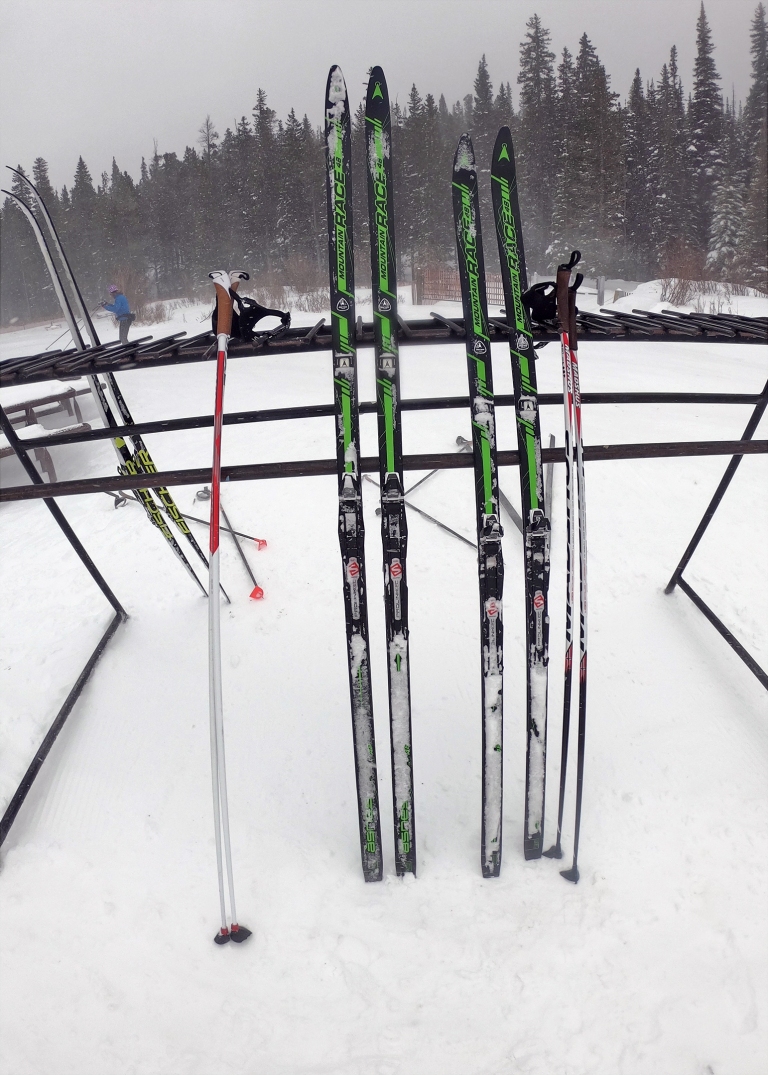
When I was a kid I had one pair of cross country skis. They were made of wood, had 3-pin bindings and worked for everything. I’d use them to go for weekend skis with my mom and dad on the endless tracks at Nordmarka outside Oslo. If we decided we wanted to leave the tracks and bushwhack across the forest or meadows, I’d use them for that too. Our school would have monthly cross country ski races and at recess, we’d build jumps and launch ourselves off them (I got a good black eye from an errant landing). They worked for that too. They were utilitarian, jack-of-all-trade skis.
A quick look at our ski rack today and it’s easy to see we’ve diverted heavily from the one ski quiver. To our defense, we’ve been working in the ski industry for almost a decade now, where pro-deals are the candy to entice people to stick around. Lately though, I’ve been thinking about simplifying things and I’ve been wondering if it’s possible to have a ski that actually works well on groomed tracks and in the backcountry?
On a recent trip to the motherland I spotted a new Åsnes ski in a shop in Oslo called the Mountain Race 48 that caught my attention. Featuring a narrow profile and sporty, green racing stripes, it was svelte, sexy and light to the touch. And yet, it had some features to make it backcountry worthy, including 3/4 length metal edges and Åsnes’ signature skin lock system for climbing steeper hills deeper in the mountains.

It is also a waxable ski. In the U.S., when people buy backcountry nordic touring skis, they almost always buy waxless skis. Most of these skis handle poorly, to the point where they really detract from the enjoyment of the sport. It’s kind of like…if mountain bikers were all still riding fully-rigid 26″ inch bikes with steep head tube angles. Yet in America, waxless backcountry nordic skis are pretty much the name of the game. Things have not evolved much and as such the sport has stagnated in this country.
To truly enjoy backcountry nordic skiing, I believe a willingness to delve into wax is essential. Yet it seems the concept of waxing has paralyzed most U.S. recreational nordic skiers to utter fear. Sure, racers use a gazzillion different waxes, but for touring it’s so simple. Pick up some Green, Blue Extra, and Violet and call it good. Learn how to apply it and wax away, a process that takes about sixty seconds at the trailhead.
In addition to a simple wax kit, Åsnes’ skin lock system is a game changer. Utilizing a narrow 35 mm mohair kicker skin that is easily applied under the ski, a skier can completely avoid using sticky and cumbersome klister wax when temperatures rise above freezing. The little kicker skins glide, they kick, they do everything needed for a good day on warm snow.
Elaine and I picked up a pair of the Mountain Race skis with the intent to use them on light and fast nordic backcountry adventures, As such, we decided to shun heavier NNN BC gear and installed standard NNN track bindings on them. We did an adventure last week during a rare April cold snap that highlighted the perfect scenario for these unique skis.
When we woke up it was 15° and snowing, the kind of day that absolutely begs for a nordic classic ski. But it’s been a long season and Elaine and I were looking for something a little more low key and in nature than another seven laps around Eldora’s groomed trails. We also didn’t want to slog around in our leather boots. We wanted the best of both worlds, so we grabbed our Mountain Race skis, stuffed our anorak pockets with wax, a cork, kicker skins and some chocolate and headed to Eldora.
We started our ski on groomed trails, covered with an inch or two of new snow. We quickly found the sweet spot for ideal kick on the wax pocket and commented to each other, “hey, these ski like normal classic skis.” In the track they kicked and glided fast and light.
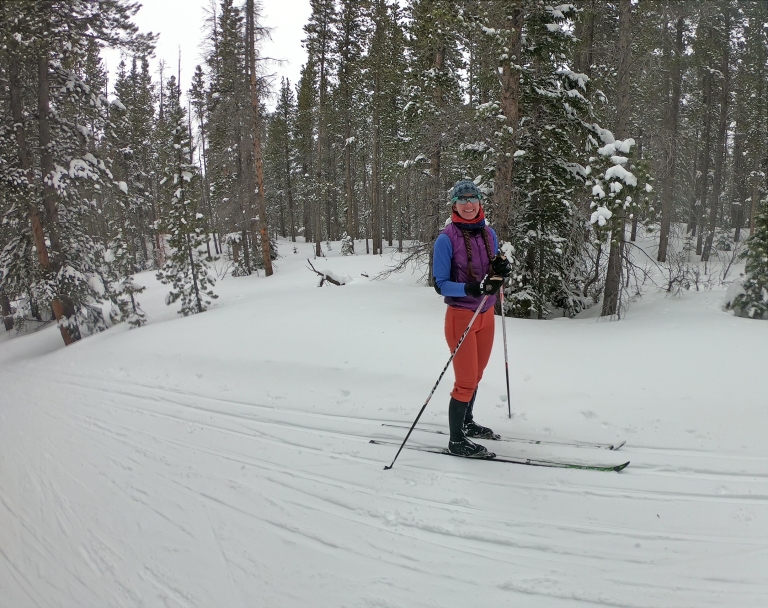
We hopped on an aptly named trail called Roller Coaster and immediately noticed that they descended a lot better than normal classic skis. Wind had blown in some snow drifts that deflect race skis, but these cut through the consolidated new snow no problem. The tips have a smidge of early rise rocker, which helps them maneuver and negotiate rough terrain.
For fun we looped over to Beaver’s Revenge, the steepest downhill at the entire area, and pointed them straight. The skis were absolutely confidence inspiring and fun…they rocked on the downhills. We backtracked and herring-boned back up the steep hill. Instead of doing the same loops over and over, these skis wanted to play and explore.
We looped around Buckeye Basin, impressed by how well they performed in the track, not slow at all, even nimble. We continued skiing to the base of Rising Sun, a steep backcountry nordic trail that would be an absolute nightmare on normal classic racing skis. We pulled out our 35 mm mohair kicker skins and began working our way to the top of Tennessee Mountain and the high point of the nordic center.
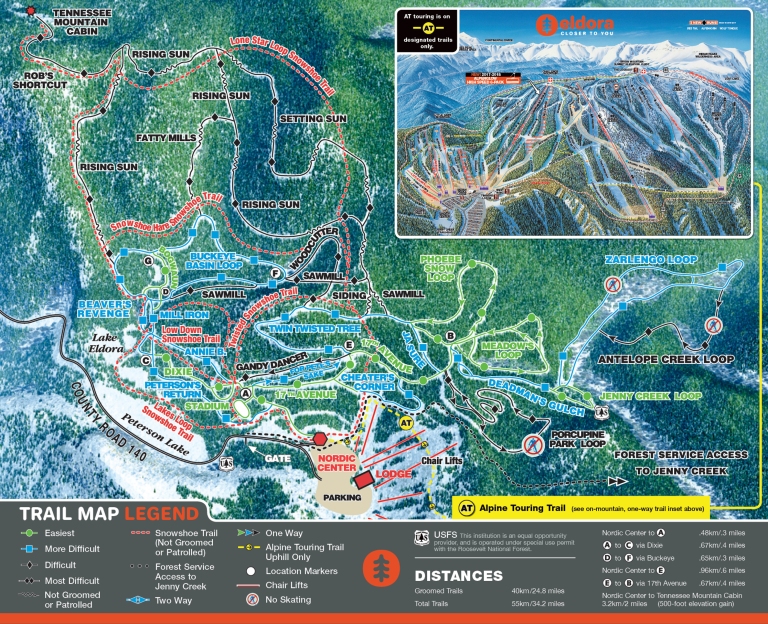
The trail was steep enough that we still had to occasionally herringbone, but for the most part the skins allowed us to walk right up. For this type of “mixed” skiing, it’s a good idea to put a slightly bigger basket on the poles, as my race baskets were occasionally sinking in on the soft side snow. There is no need to go with a backcountry pole however, as the intent of this type of skiing is to be able to ski in the backcountry but still have a functional set-up for the track.
We crested the climb, and kept the skins on across the rolling terrain to Tennessee Mountain Cabin. The 35 mm mohair skins glide well and offer more purchase on the loose new snow than just blue wax. A light snow was being whipped into a frenzy by a strong wind blowing off the Continental Divide, so we gladly ducked into the cabin, lit a small fire, and enjoyed some Norwegian chocolate in the rustic simplicity.
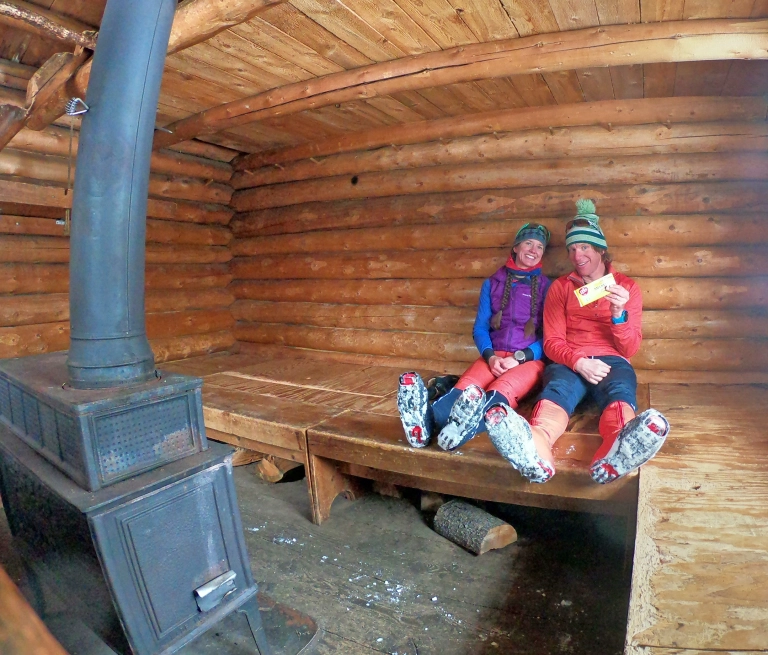
This is something I miss with just straight track skiing – the ability to be deep in nature, away from people. On the other hand I love the light, fast and free feeling of a fast classic or skate ski. It seems the Mountain Race skis offer the best of both worlds: wild and fast freedom. It is an intoxicating combination.
We left the cabin and made our way through the deep-and-getting-deeper snow along a ridge line to the Setting Sun trail. The trail climbed steadily to an opening, where it switchbacked and crossed over Volkswagen sized drifts shaped from a winter of windy rowdiness. This type of terrain is a nightmare on regular classic skis – kind of like driving a rough jeep road in a Lamborghini – but the Mountain Races ate it up with aplomb.
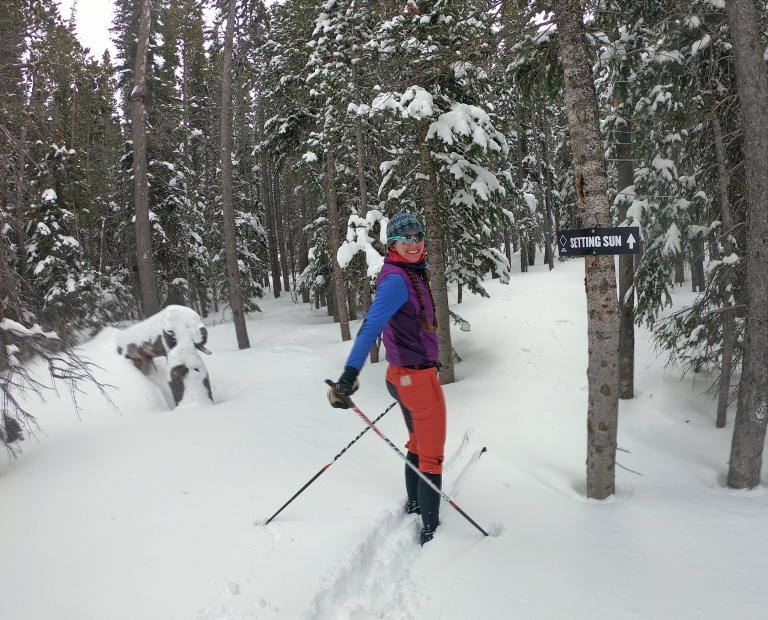
We crested the top, removed the kicker skins, and began a long descent back to the groomed nordic trails. It was a ripping downhill and we were even able to drop the knee and make some telemark turns, whooping and hollering with the joy that only skiing in a snowstorm can create.
Back on the nordic trails, we hopped onto Phoebe Snow and Meadows Loop – passing some skate skiers along the way, something that would never, ever happen on a wide backcountry nordic ski – and enjoyed perfect kick and glide and the sensation of moving fast. It was time to go home, but not before a fast drop on Gandy Dancer, where once again the descending capabilities of the skis shined.
It seems, more and more, genres of sports are blending. The most popular type of cycling these days is gravel riding, a melding of mountain biking and road biking into a style that is tough, fast and versatile. Same goes for trail running and hiking, where the lines and gear used for backpacking and traditional jogging are completely blurred. In this era of increased reliance on complex technology there seems to be a movement towards outdoor gear that offers versatility and less complexity, or in this case, one nordic ski to rule them all! It makes sense: the simplicity of the outdoors is a needed medication to the complexity of the other, real world.
Even without a higher cause for the greater social good, this type of hybrid Nordic skiing is fun. Probably the coolest thing about it is it opens up the mind to new possibilities. In essence, it basically doubled the skiable terrain we can normally enjoy at Eldora Nordic Center, and in turn enriched the experience. The only thing I’m disappointed about is we didn’t figure this particular ski out until the very end of the season. It’ll certainly be something to look forward to next winter.
Of course, no gear is perfect and this set-up has some limitations. If I was trying to win a 50 km classic race, this would not be my ski of choice (bigger lungs would be my choice). It’s a little too heavy and there are better skis out there for that endeavor. Conversely, if my daily ski consisted of running a trap line in Canada’s Northwest Territories breaking trail through 18 inches of new snow everyday, this wouldn’t be my ski of choice for that either, as I’d want something a lot wider and beefier. But for somebody who enjoys skiing the track and backcountry equally and doesn’t want a bunch of different pairs of skis, the Mountain Race is about perfect.

The most difficult decision regarding this ski is what binding to put on it. I skied it with my normal Madshus classic NNN boots, and felt a little under-gunned on the tight, twisty trails at Brainard Lake. Elaine used it with a combi boot that has a stiffer sole and, more importantly, more lateral stiffness, and had good luck. In this case, I’d recommend steering clear of the most expensive boots, as more recreational models are generally stiffer and have more insulation.
No doubt, this ski paired with NNN BC bindings and boots would absolutely rock for Brainard-style, tight, twisty conditions, while giving up some performance at the track. For something like skiing across Greenland or Expedition Amundsen, where pulling a pulk adds additional balance concerns, I’d certainly install an NNN BC binding and use an appropriate boot (At Expedition Amundsen, it was THE ski of choice for the fastest competitors). And while I love the simplicity of 3-pin boots and bindings, to me that’s not a good option for a ski I plan to use at least a little bit in the track, as the sides of the binding will drag on the grooves.
I’d say if the intended purpose is 70% or more backcountry, install it with NNN BC. Anything less than that, and it’ll work better with a regular nordic NNN binding and a combi boot with some stiffness in the uppers. Of course, better skiers can get away with less boot stability, and visa versa.
The biggest single problem with this ski is availability. Åsnes skis are very hard to get in the United States, and the Mountain Race 48 ski isn’t something shops currently bring in because it breaks the image of a traditional backcountry nordic ski. A grand total of three Mountain Race skis were shipped to the U.S. last year (a 180, 190 and 200 cm) It’s a tough sell in a category that doesn’t generally generate much enthusiasm in the first place.
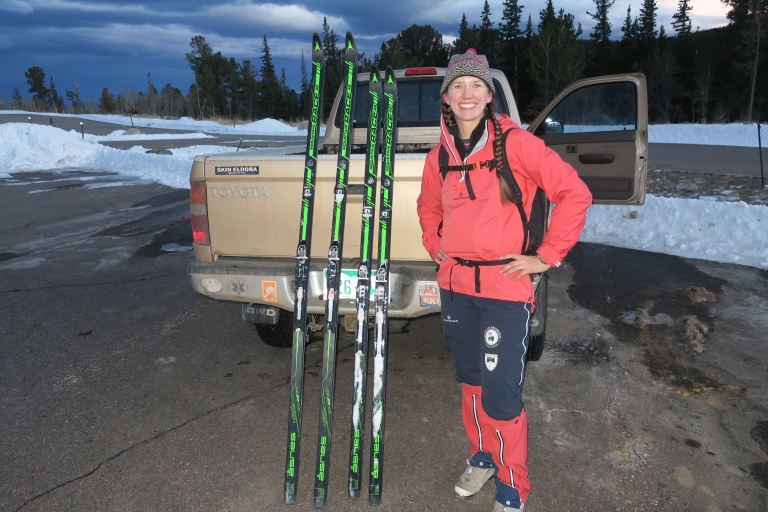
Which, I suppose, is part of the motivation for writing this review…showing the beauty of this type of hybrid skiing and making the skis more available to North American nordic skiers! If the people demand it, it will arrive.
In the interim, what’s a skier to do? Go to Norway and buy a pair there? Well, there are worse options in the world. Roundtrip flights to Oslo on Icelandair or Norwegian Air cost about $500 in the winter. It wouldn’t be that difficult to fly in with just a backpack and boots, take the train into the city, go to a shop that sells the skis, give the shop tech a little tip to mount them quickly, and head out into the amazing Norwegian forest for a backcountry/track adventure of a lifetime. If this seems intriguing, message us and we’ll gladly share more information.
In the interim, we’ll keep our eyes peeled for other skis that are waxable, narrow, 3/4 edged, offer a skin lock system and are available in the United States. As far as we know, the Åsnes Mountain Race 48 is the only ski in the world right now that has all these traits.

Love the fact that waxed skis are still around. A waxless ski is like automatic in a car. It might be easier, but it doesn’t give you a hands-on experience. For me waxing, and choosing the prefect wax, was always part of the fun. Though I am glad there’s an alternative to gooey klister.
LikeLike
Hi. I’m new to XC and want to get something that can cover a few bases, and this ski looks ideal (or the madshus M44). But I am also torn between the bindings as you state above. I like the idea of the freedom/lightness of an NNN binding/boots (plus better choice) compared to NNNBC. I wondered what your thoughts are regarding choice of binding now, after a bit more time with it?
LikeLike
I can’t tell if my last attempt at this comment worked or not, so I’ll make this one more succinct: I wondered what your thoughts regarding binding choice (NNN vs. NNN-BC) were now, after a bit more time with the ski?
LikeLike
Can’t speak to “Mountain Race” but I’m personally responsible for having 2 pairs of Asnes “Mountain Tour 51” sent to my house in the USA – 210 waxing and the 205 fishscale. Love these skis!
MT51’s are slightly wider & heavier than MR and slanted a little more toward the BC end of things vs. the track. If you must fulfill your Asnes desires head to http://www.sportalbert.de
LikeLike
Thanks for the review on this ski. I do like a “do it all ski”. With a burlier boot I’ve pushed the old Fischer bc Country (wax) skis into all sorts of duties. Its getting harder to get a taxable like that. I do also like my Anses Admunsens but often could get away with less ski. I’ve been eyeing up the Race 48. Might be my next ski.
LikeLike
We bought on line a pair or rc-48 for my wife (500 cnd dollars) and after two mounts of tracks and bc skiing, our guess was a complete succes. We choose the standard nnn binding system and confort and controll are fully satisfying. I already have 4 pairs of skis but I think I will buy an other pair of rc-48 for myself. If these skis are good for the next ten years, it will a good investment
LikeLike
Hello,
I’m wondering if you can apply a kick wax to these skis for warmer conditions when you take the skins off?
LikeLike
Way cool! Some extremely valid points! I appreciate you writing this write-up and the rest of the site is very good.
LikeLike
Pretty! This has been a really wonderful post. Thank you for providing these details.
LikeLike
bookmarked!!, I love your site!
LikeLike
Good info. Lucky me I ran across your site by chance (stumbleupon). I’ve book-marked it for later!
LikeLike
Right here is the right web site for anyone who really wants to find out about this topic. You know a whole lot its almost tough to argue with you (not that I personally would want toÖHaHa). You definitely put a brand new spin on a subject which has been written about for many years. Excellent stuff, just wonderful!
LikeLike